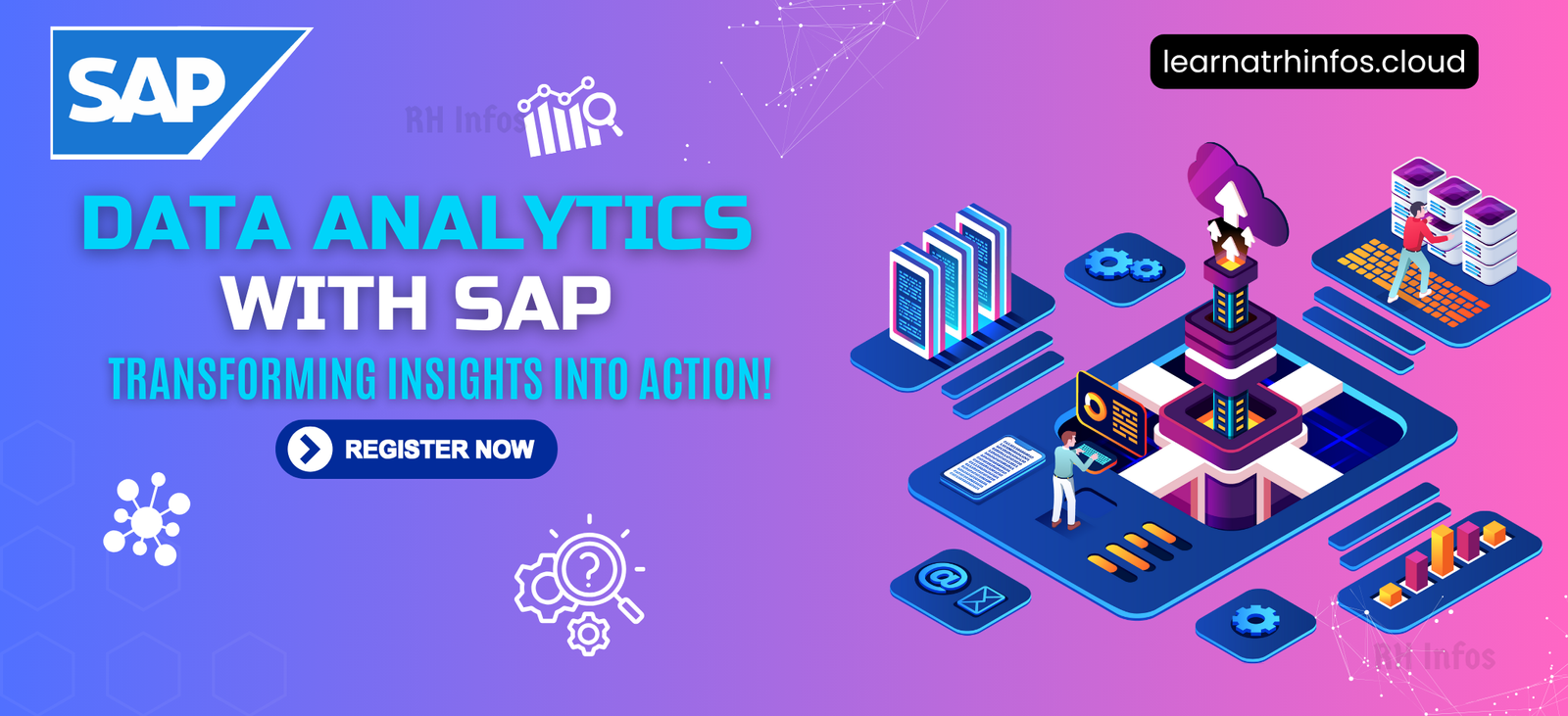Estimated Read Time: 6-7 Minutes
Data Analytics
1. Explaining Data and Analytics in an Overview
- SAP tools for data management and analytics, including SAP Datasphere, SAP HANA Cloud, and SAP Analytics Cloud.
- How these tools support the integration, management, and analysis of data to gain valuable business insights and make data-driven decisions.
– Data and Analytics overview
– SAP Datasphere overview
– SAP Analytics Cloud overview
– Data fabric overview
– SAP HANA Cloud
– SAP Master Data Governance.
2. Data and Analysis
- This section provides an overview of the various SAP tools that aim to simplify and improve the access and management of data. The tools include SAP Datasphere, SAP HANA Cloud, SAP Analytics Cloud, and SAP Master Data Governance.
- SAP Datasphere enables integrated data management, SAP HANA Cloud is a versatile database for intelligent applications, SAP Analytics Cloud offers solutions for business intelligence, planning and predictive analytics, and SAP Master Data Governance improves the control of master data.
The Data and Analytics area includes the following tools:
– SAP Datasphere
– SAP HANA Cloud
– SAP Analytical Cloud
– SAP Master Data Governance
3. SAP Datasphere
- SAP Datasphere is a tool that supports data integration, cataloging, semantic modeling, data warehousing, and virtualization for SAP and non-SAP data.
- It harmonizes heterogeneous data and provides a central platform for managing and using this data.
- SAP Datasphere is a unified service for data integration, cataloging, semantic modeling, data warehousing, and virtualization of workloads for SAP and non-SAP data.
- With SAP Datasphere, data experts can easily distribute business-critical data across their organization’s entire data landscape while maintaining business context and logic.
Capabilities
The most important capabilities are:
– Access Authoritative Data
– Enrichment of all data projects
– Simplify your data landscape
4. Access Authoritative Data
- SAP Datasphere enables direct access to business-critical data and metadata – and the critical relationships between them – from SAP applications. With the new SAP Datasphere Analytic Model, data experts can easily solve complex requirements for semantic modeling of business data.
- The automatic reuse of semantic definitions and associations from SAP applications shortens time-to-value and simplifies the steps that data experts must take across the organization to deliver business-critical data. SAP Datasphere Catalog also makes it easier to find, manage, and control data automatically.
- In addition, cataloging of data stored in SAP Analytics Cloud and SAP Datasphere is offered at no additional cost.
5. SAP Analytics CloudAC
- SAP Analytics Cloud is an all-in-one cloud product offered as software as a service (SaaS) for business intelligence (BI), planning, and predictive analytics.
- Built natively on SAP Business Technology Platform (SAP BTP), it provides a unified and secure public cloud experience to maximize data-driven decision-making.
Analytic Applications:
With SAP Analytics Cloud, analytics designer, you can create analytic applications for data analysis and data planning. In analytic applications, you can configure the behavior of the UI elements with a set of specific script API events and specify which actions must take place when events are triggered.
Data Analyzer:
– In SAP Analytics Cloud, you can start ad-hoc analyses with a data analyzer – a predefined ready-to-run service for multidimensional, pivot styled ad-hoc analysis for SAP BW Live queries, SAP HANA Live views, SAP Datasphere models, and SAP Analytics Cloud models.
– SAP BW queries and SAP HANA views can be accessed directly and no additional model needs to be created. The data can also be displayed in charts.
6. Data Fabric
Introduction :
– A data fabric is a combination of a data architecture and special software solutions that centralize, link, manage, and control data across systems and applications.
Definition of a Data Fabric :
- Data fabric solutions link and manage data in real time across different systems and create a centralized data source. They enable needs-based access and automate data management.
- They also rationalize data in complex, distributed architectures, and prepare it for analysis and machine learning by standardizing, cleansing, and securing it. Data fabric solutions therefore allow companies to use their data efficiently and scale their systems dynamically.
Data Fabric Architecture:
A data fabric architecture links, manages, and controls data across systems and applications, providing a centralized and uniform view of the data.This applies to both the teams and the systems at every point in your organization.The most important components of a data fabric architecture include:
Data connectors
you can think of data connectors as bridges that connect different systems where the data is stored (for example, databases, applications, sensors) at a central point. In this way, all data sets can be analyzed from a central point.
Data management
The aim here is to ensure that the data is structured, secure, and of high quality. This includes tasks such as data integration (merging data from different sources), data governance (defining rules for the use and management of data), and data security (protecting sensitive data from unauthorized access).
Data modeling and semantic layer
This step helps you to understand the data by creating a common language for the data from the different systems. This involves creating a model and a semantic layer. While the model describes the data, the semantic layer represents the agreed language for the “story” of the data.
Data processing and analytics
This is where the data is processed and analyzed to gain important insights. This includes tasks such as data warehousing (storage of large amounts of data), data streaming (continuous processing during creation), and data visualization (easy-to-understand presentation of the data).
Automated data management
While data analysis is at the center of automation in various business areas, in the architecture context it is more about the efficient and consistent management of data. This includes the automation of tasks such as data integration, data governance, and data security. Through automation, companies can reduce errors, save time, and improve data quality.
7. SAP Hana Cloud
- SAP HANA Cloud, still a rather new product, offers a quick and easy way to store data, process it in real time, and link it to other data sources in the cloud or on-premise. It combines in-memory technology with the advantages of cloud computing also offering various features like machine learning and artificial intelligence.
- Operating as stand-alone solution or as add-on to an on-premise environment, SAP HANA Cloud allows unique use cases offering great benefits to its users.In this call our SAP HANA Cloud Product Management Expert Thomas Hammer will give you an introduction to SAP HANA Cloud. Explaining key features and specific benefits while introducing the newest technological advances.
- SAP HANA Cloud is a multi-model database management system that empowers the architects of the future to build and deploy the next generation of intelligent data applications at scale.
8.SAP HANA Cloud Architecture
- The SAP HANA Cloud provides the database and data management service to SAP Analytics Cloud, SAP Data Warehouse Cloud, SAP Business Applications, and third-party applications.
- Within SAP HANA Cloud, you’ve the choice between several storage options. The storage options are:
SAP HANA Cloud, SAP HANA database:
A powerful in-memory database system combining OLTP + OLAP technologies, complemented with a multimodel engine for relational and document data.
SAP HANA Cloud, data lake:
A market-leading analytics data platform, providing high-performance, on demand analytics, supporting customers with timely, data-driven insight.
9.SAP Master Data Governance
- A unified, trusted view of your business enables you to work more efficiently and make better decisions. The SAP Master Data Governance application helps you pull together master data and manage it centrally using a master data management layer based on SAP Business Technology Platform.
- SAP Business Technology Platform (SAP BTP) is an open Platform-as-a-Service (PaaS) offering that delivers in-memory capabilities, core platform services, and unique services for building and extending the intelligent, mobile-enabled cloud application. SAP BTP is the foundation for SAP Master Data Governance, cloud edition.
- SAP Master Data Governance, cloud edition is a Software as a Service (SaaS) solution that supports you in maintaining a high level of master data quality, offering capabilities to manage the core attributes of business partners and to evaluate their quality. It offers the capability to centrally govern core business partner data to kick-start an MDG initiative at low entry barriers.
Unlock Insights with SAP Data Analytics
Leverage SAP’s powerful data management and analytics tools to drive informed decisions. Contact us to explore how SAP BTP can transform your data strategy.

